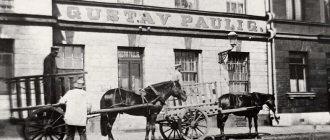The history of the oldest Finnish company Paulig Group began with an advertisement in the Helsinki city newspaper: “We offer a wide selection of colonial goods! We deliver to your door!” The indicated address informed potential buyers that a new store had opened at 10 Fabian Street. This is how twenty-year-old German Gustav Paulig presented his business in the Finnish capital. He could hardly have imagined that the company he founded would become the leader of the coffee market in Finland and the Baltic countries, and that the dark chocolate-colored label with his name in white letters would be looked for on store shelves by coffee lovers throughout Europe.
Brand history
The young man came from Lübeck to the Grand Duchy of Finland, which at that time was part of the Russian Empire, in 1875. Gustav Paulig wanted to see the world and try his luck in search of an activity that would become his life's work. He initially settled in Tampere and got a job at Nokia, which at that time was a small pulp factory. And its owner, Frederic Idestam, had no idea about the prospects of his enterprise.
Gustave worked at the factory for a year, and then moved to Helsinki, deciding to open a shop of colonial goods. This was the name given to tea, coffee, spices - everything that was exported from the colonies. The young man decided to focus on coffee, and he was right. When Gustav met Bertha Bonhoff, fell in love and decided to marry in 1876, he was the owner of a successful business and a promising groom.
Brand founder Gustav Paulig and his wife Bertha
At first, the newlyweds lived in a small house on a plot of land that belonged to Bertha's father. And then, when the coffee bean roasting factory Paulig built was in full operation, he rented half a hectare of land near the bay and bought a villa located on that site. The new home was renovated and a cozy family home was created, in which three sons and 4 daughters of Gustav and Bertha were born and raised.
Known for his strict moral principles, Gustav Paulig tirelessly repeated to factory workers and salesmen: “Compromise on quality is unacceptable!” He taught the same to his children. When he died suddenly at the age of 56, his successor, his middle son Eduard, studied in Lübeck, and Bertha took over the company. She was the first female manager of a Finnish company.
For her expanding production, Bertha acquired a large plot of land and commissioned the design of a seven-story commercial building from the architect Woldemar Asperin, who was a friend of her late husband. In the meantime, while the project was being developed and construction was underway, she made an important deal with a Danish entrepreneur working in Helsinki who was experiencing financial difficulties: she bought from him 3 coffee shops and a popular coffee shop in the city center. After 2 years, the Paulig chain operated 25 coffee shops and a bakery, which, in addition to bread and rolls, baked baked goods specifically for coffee.
Construction of the new company building was completed in 1911. There was a place in it for a bean roasting workshop, the alluring aroma of which penetrated every corner, an office, a tasting room, and a warehouse for finished products. By that time, Eduard Paulig had returned after training, to whom Bertha handed over the reins. But before the new leader could take on the role, the First World War began. The import of coffee into Finland was stopped, and in order not to completely lose customers, Eduard Paulig began preparing a coffee drink from acorns, chicory and dandelion root.
The food crisis lasted until 1921: after the revolutionary coup in 1917, Finland declared secession from Russia, recovered from the military devastation, and formed a government. Only then did the Pauligs have the opportunity to import coffee beans, albeit at a very high price.
Back in 1919, Bertha reformatted the company, making it a joint-stock company, the shares of which were distributed among all family members. Eduard Paulig was elected executive director, who managed the company from 1919 to 1947. Bertha, at this time, was engaged in charity work, supported the poor, and even created a preschool institution with Aurora Karamzina, which still operates today - the Bertha Maria Hemmet kindergarten.
In the 50s, the board was headed by the grandson of the brand’s founder, Henrik. He had many ideas for the development of production, which gradually began to be implemented:
- moved the roasting and packaging shops to new premises;
- organized a service for interaction with consumers;
- published a collection of recipes;
- organized thematic meetings, the participants of which could get acquainted with the company’s products.
In 1980, Paulig established its own Coffee Institute to promote knowledge about the product, which became the basis of the family business. In the 90s, the company acquired another production site - a British bean roasting factory, and built factories in Tallinn and on the outskirts of Stockholm. In the period from 2006 to 2011, 3 more enterprises were built, one of them in Russia.
After 140 years, Paulig remains a family business, a market leader in the Baltics and Sweden. And the favorite brand of Finns, Swedes, Latvians and Danes.
Paulig - brand history
Paulig Group (pronounced Paulig group) is a Finnish company, a famous coffee producer. The company's headquarters are located in Helsinki.
The history of the Paulig company begins in 1876, when Gustav Paulig, having arrived in Finland from Germany, opened his own business. The food industry was just taking its first steps in its development. Trade in food products that had not undergone any processing predominated. Gustav Paulig began his entrepreneurial activities by importing and selling colonial goods such as salt, coffee, spices, flour, port wine and cognac.
A newspaper ad from that era told readers: “Wide selection of colonial goods. Delivery is in progress. Office at 10 Fabian Street, Helsinki.”
Gustav Paulig very quickly became a well-known entrepreneur and business enthusiast who put new ideas into practice. He was the first to understand the importance of a brand and created the first company logo back in the 1880s. The sign in the form of the Latin letter “P” appeared on the packaging of Paulig coffee, symbolizing high quality. For Gustav, the quality of the product was above all else. He bequeathed his attitude to maintaining quality to subsequent generations of the family. In 1907, after Gustav's death, his wife Bertha Paulig took over the company.
In 1904, Paulig expanded its scope of activity: from wholesale trade the company moved to food production. At that time, only green coffee beans were sold and coffee was roasted at home. At first, the coffee supplied by Paulig was also green beans. At the end of the 19th century in the USA, John Arbuckle developed the technology for industrial coffee roasting. Gustav Paulig adopted it, and very soon a coffee roasting production, the first in the Nordic countries, was established in warehouses located in the Katajanokka area in Helsinki.
After Gustav Paulig's death in 1907, his wife, Bertha Paulig, took over the helm of the company.
In 1909, Paulig acquired the Nissen chain of coffee shops and coffee shops. A few years later, the Nissen chain of establishments became very popular among Helsinki residents, and soon Nissen stores and coffee shops operated throughout Finland. This contributed to the spread of Paulig products throughout Finland.
In 1926, demand for roasted coffee in Finland exceeded sales of raw beans.
At first, Paulig delivered roasted coffee to coffee shops in five and ten kilogram packages. In 1924, the company received a letter from merchant Matthias Ericsson asking about the possibility of packaging coffee in packs of 250 and 500 grams. Paulig appreciated this idea and was the first in Finland to begin supplying coffee in consumer packaging.
In 1929, in honor of the 25th anniversary of the coffee roasting plant, Paulig released its first coffee brands, Juhla and Presidentti. They became the predecessors of the modern brands Juhla Mokka and Presidentti. Before this, the Paulig company produced its coffee blends under numbers; they did not have their own names. In 1931, ground coffee appeared on store shelves. At the same time, the production date began to be printed on Paulig coffee packages so that the consumer was confident in the freshness of the product. This was an innovative solution that Paulig pioneered in Europe.
Eduard Paulig, son of Gustav and Bertha, managed the company from 1919 to 1947. It was during this time that Paulig grew greatly and became a major player in the food industry.
During World War II, the company began producing a new type of product - frozen foods. Coffee production was paralyzed between 1939 and 1946 as the supply of green coffee from abroad was completely stopped.
In 1942, construction of the first deep-frozen food production plant was completed.
In 1950, a girl named Paula became the “face” of the Paulig company. Edward's son, Henrik Paulig, brought this idea with him from America. Young Paula in the national costume of the Saesmeki region, pouring coffee from a copper coffee pot, became the embodiment of the spirit of the Paulig company. She attended various company events and soon became the face of Paulig.
The growing company became cramped in the old premises. In 1968, the coffee roasting and packaging plant moved to a new modern building in the Vuosaari area. The opening ceremony was attended by the country's President Urho Kekkonen.
From his foreign tour, Henrik Paulig brought back the idea of organizing a service for interacting with consumers. The project was named Paula. The project included consulting consumers by phone and mail, as well as creating collections of recipes and organizing thematic meetings introducing participants to the company’s products.
In 1980, Paulig opened its Coffee Institute to promote knowledge about coffee. Coffee roasting production has undergone another renovation, which coincided with the introduction of new roasting and packaging technologies. The first steps to internationalize the company's activities were made in the UK market, where Paulig acquired the coffee company Appleton Machin & Smiles Ltd, renaming it Paulig UK Ltd.
The 1990s in the history of Paulig were marked by internationalization and globalization. Paulig's location, Vuosaari, has gradually developed into a large urban area with developed infrastructure. In the Baltic markets, Paulig was one of the first companies to renew trade relations with its old partners. The Paulig coffee roasting plant in Tallinn's Saue district was built in 1993.
In Russia, Paulig has opened sales offices in St. Petersburg and Moscow.
In January 2006, a plot of land was purchased for a new coffee roasting plant, and the final decision on significant investment in this regard was made that same autumn. Paulig has been and remains an innovative company that actively expands its product range, listens to consumers and is willing to develop new products and introduce new production methods for them. Despite constant development, the fundamental idea of its existence remains unchanged: to provide consumers with products of the highest quality that best meet their needs.
The site for the construction of a new coffee roasting plant was purchased in January 2006 from a business park in the new seaport of Helsinki. In the autumn of the same year, the final decision on significant investments was made, and the completion of the main construction work took place in the summer of 2008. The new plant was inaugurated in January 2010.
In 2009, the company began construction of a coffee roasting plant (with a capacity of 6 thousand tons of coffee per year) in the Tver region of Russia. On September 15, 2011, the official opening of the plant took place in the Borovlevo-2 industrial zone.
In March 2012, a new general corporate identity was introduced.
Interesting Facts
The symbol of the Paulig company was the smiling girl Paula, whose image in national costume adorned packs of branded coffee from the 20s to the 80s. There is a family story according to which Gustav Paulig really liked the girl and really liked her. A portrait of Paula pouring coffee from a copper pot appeared on advertising posters and packaging in 1926. But even now an annual competition is held among the company’s employees: the most beautiful one receives the right to bear the title of Paulig girl - Paula.
83% of Finns love coffee, 88% of them drink it daily, 85% choose Paulig.
Until 1929, the company produced coffee under numbers; they did not have names. The first names appeared when the grain processing factory turned 25 years old: Juhla and President became the predecessors of the modern Mokka and Presidentti.
Until 1931, the company sold coffee only in beans; the idea to offer customers ground coffee belonged to Bertha. At the same time, at Eduard’s suggestion, the packaging began to indicate the date of manufacture - the first in Europe. There is no instant coffee in the brand’s assortment; this is the company’s principled position. All Paulig varieties are of two types - beans and ground, except for the Cupsolo coffee machine created.
The modern logo and slogan: “Know the best taste” appeared in 2012 as a reflection of the universal passion for good coffee, delicious food and a bright, rich life. The idea was developed by the company's advertising bureau.
Paulig representative explains how to distinguish real coffee from fake
The taste of coffee depends on many factors. First of all, it depends on the cooking method. Important factors are also the cleanliness of the equipment, the place and conditions for storing coffee at home or in a store, and additional ingredients. Paulig assured us that their experts know where and what kind of coffee to buy so that, despite the natural conditions that change every season, your favorite taste remains the same.
How to identify a fake as a real Paulig
In general, it is not difficult to distinguish original products from counterfeit ones. The grains in the package are usually overcooked or broken, the taste is alarming, and there is no aroma at all. But all this can be discovered only after opening the package, so even a beginner can handle it. It is much more difficult to distinguish the original from the fake while still in the store. An almost impossible task even for an experienced expert.
Fraudsters have learned to counterfeit packaging very skillfully, admits Viktor Balalaev, a coffee purchasing specialist in an online store. All risks can be minimized by following a few tips from our interlocutors:
- First, and perhaps most important: you should only buy products in trusted stores.
- Inspect the packaging carefully. All seams must be smooth and well taped on both sides. Pay attention to the expiration date and roasting date. Fuzzy font, uneven edges, missing barcode or gluing on only one side are all reasons to question the authenticity of the product.
- The barcode is necessarily individual and inherent in each product.
- The manufacturer is indicated in the expiration date field as the number 2, which means Paulig Rus LLC, Russia, 170540, Tver region, Kalininsky district, Burashevskoye rural settlement, Borovlevo-2 plant, complex No. 2
- Also look at the degassing valve - in a fake it will most likely be just an imitation.
- You can compare the packaging with the image on the brand’s website. Sometimes manufacturers change designs, but scammers can’t keep up.
- Big discounts, alas, are not always good. Sometimes they should alert you - especially if these are not the stores from the first point.
- The smaller the volume, the lower the risks. Most often, packages of 1 kilogram or more are counterfeited.
Do not forget that the consumer can always request to provide documents for the products. Or return a product of inadequate quality in accordance with the Law “On Protection of Consumer Rights”. Even after opening the package. Any self-respecting store will return your money without additional examination, but, just in case, we recommend that you immediately record all visible defects in packaging and grain on camera to make it easier to prove that you are right.











